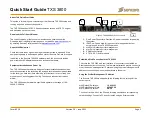
SWRS046H – NOVEMBER 2006 – REVISED MARCH 2015
5.20.6 Frequency Hopping Spread Spectrum Systems (FHSS)
Due to the very fast locking properties of the PLL, the CC1020 is also very suitable for frequency hopping
systems. Hop rates of 1to100 hops/s are commonly used depending on the bit rate and the amount of
data to be sent during each transmission. The two frequency registers (FREQ_A and FREQ_B) are
designed such that the ‘next’ frequency can be programmed while the ‘present’ frequency is used. The
switching between the two frequencies is done through the MAIN register. Several features have been
included to do the hopping without a need to re-synchronize the receiver. For more details, refer to
Application Note
AN014 Frequency Hopping Systems
(
In order to implement a frequency hopping system with CC1020 do the following:
Set the desired frequency, calibrate and store the following register settings in non-volatile memory:
STATUS1[3:0]: CHP_CURRENT[3:0]
STATUS2[4:0]: VCO_ARRAY[4:0]
TEST1[3:0]: CHP_CO[3:0]
STATUS3[5:0]:VCO_CAL_CURRENT[5:0]
Repeat the calibration for each desired frequency. VCO_CAL_CURRENT[5:0] is not dependent on the RF
frequency and the same value can be used for all frequencies.
When performing frequency hopping, write the stored values to the corresponding TEST1, TEST2 and
TEST3 registers, and enable override:
TEST2[4:0]: VCO_AO[4:0]
TEST2[5]: VCO_OVERRIDE
TEST2[6]: CHP_OVERRIDE
TEST3[5:0]: VCO_CO[5:0]
TEST3[6]: VCO_CAL_OVERRIDE
CHP_CO[3:0] is the register setting read from CHP_CURRENT[3:0], VCO_AO[4:0] is the register setting
read
from
VCO_ARRAY[4:0]
and
VCO_CO[5:0]
is
the
register
setting
read
from
VCO_CAL_CURRENT[5:0].
Assume channel 1 defined by register FREQ_A is currently being used and that CC1020 should operate
on channel 2 next (to change channel simply write to register MAIN[6]). The channel 2 frequency can be
set by register FREQ_B which can be written to while operating on channel 1. The calibration data must
be written to the TEST1-3 registers after switching to the next frequency. That is, when hopping to a new
channel write to register MAIN[6] first and the test registers next. The PA should be switched off between
each hop and the PLL should be checked for lock before switching the PA back on after a hop has been
performed.
NOTE
The override bits VCO_OVERRIDE, CHP_OVERRIDE and VCO_CAL_OVERRIDE must be
disabled when performing a re-calibration.
60
Detailed Description
Copyright © 2006–2015, Texas Instruments Incorporated
Product Folder Links:
















































